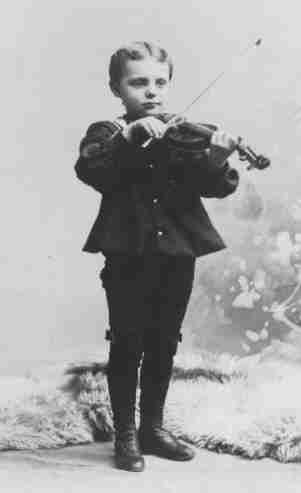
Figure 1.--This boy in the late 19th Century, probably the 1890s, wears a sailor suit to be photographed with his violin. Notice the buttons on his middy blouse and the little bows on his kneepants.


Figure 1.--This boy in the late 19th Century, probably the 1890s, wears a sailor suit to be photographed with his violin. Notice the buttons on his middy blouse and the little bows on his kneepants. |
The age at which a child should begin learning a musical instrument has been discussed for some time. Often this meant that, except for a small number of child prodigies, about 10 years of age. We now know that children are capable of learning musical instruments at a much earlier age. We also note boys photographed with the instruments they are wearing through their teen years.
We are not sure just when boys started learning musical instruments in different historical periods. We have noted paintings and bibliographical writings suggesting that very young boys in the 17th century were treated like little adults. Their education could begin quite early and difficult subjects like Latin and Greek addressed at an earlier age than we now consider appropriate. Music instruction was also begun early, but such training was only available to the narrow strata of the more affluent
Our modern concept of childhood developed in the 19th century, especially during the early Victorian era. Modern patterns concerning the age of schooling and appropriate subjects for different ages also developed at this time. Presumably attitudes toward musical instruction were also affected, but HBC has few details at this time. We do note by the late 1890s of an increasing number of photographic portraits with boys and their musical instruments. Interestingly there are fewer portraits of girls with their instruments.
We note many portraits of boys with their musical instruments during he early 20th century. There are boy of all ages photographed. Ages range from early school age boys to teenagers. For some reason, after World War I (1914-18) it seems to have become less common for bots to be photographed with their instruments. Here we do not understand why this change occurred. Clothing styles all cganged. Before the War we not a lot of boys wearing sailor suits and knicker and kneepants suits. After the War some nboys wear short pants and knickers, but by the 1930s long pants beome more common, especilly for the teenage boys.
We do not have any information at this time as to the age that boys in the 20th century would begin to learn to play musical instruments. We have the idea that parents began to get serious about musical instruction when boys reached about 10 years of age. This is, however, a topic which needs to be researched.
A now famed Japnese Music teacher, Shinichi Suzuki, reasoned that a child should be able to learn a musical instrument by four years of age or less. He noted how young children can easily master the intricacies of speech or using chopsticks and concluded that they could also bergin to learn musical instruments. The resulting Suzuki Method revolutionized the teaching of music in Japan, America, and other countries. It emphasizing
the development of their listening skills at a very young age and teaching them to play entire works by ear before they learn to read music. His methods were inspired by his observation that children learn to speak their native language with great proficiency
long before they learn to read. Philosophically, Suzuki saw music
education as a vehicle towards personal development and self-fulfillment. He encouraged his students to achieve their own happiness by bringing joy to others through music.
Related Chronolgy Pages in the Boys' Historical Web Site
[Main Chronology Page]
[The 1880s]
[The 1930s]
[The 1940s]
[The 1950s]
[The 1960s]
[The 1970s]
[The 1980s]
Navigate the Historic Boys' Clothing Web style pages:
[Kilts]
[Caps]
[Sailor suits]
[Sailor hats]
[School uniform]
[Scout]
